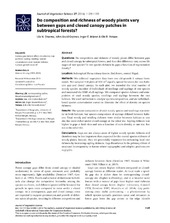Do composition and richness of woody plants vary between gaps and closed canopy patches in subtropical forests?
Peer reviewed, Journal article
Published version

Åpne
Permanent lenke
https://hdl.handle.net/1956/16171Utgivelsesdato
2016Metadata
Vis full innførselSamlinger
- Department of Geography [676]
Originalversjon
https://doi.org/10.1111/jvs.12445Sammendrag
Questions: Do composition and richness of woody plants differ between gaps and closed canopy in subtropical forests, and does this difference vary across life stages of tree species? Is tree species richness in gaps a function of regeneration density? Location: Subtropical Shorea robusta Gaertn (Sal) forest, central Nepal. Methods: We collected vegetation data from two old-growth S. robusta forest stands. We sampled 128 plots of 100 m2 equally spread between the two habitats: gap and closed canopy. In each plot, we recorded the total number of woody species, number of individuals of seedlings and saplings of tree species and measured the DBH of all saplings. We compared species richness and composition of total woody species, seedlings and saplings between the two habitats. We used ordination to analyse species composition, and an individual-based species accumulation curves to illustrate the effect of density on species richness. Results: The species composition of total woody species and seedlings was similar in both habitats, but species composition of saplings differed between habitats. Total woody and seedling richness were similar between habitats at one site, but were richer under closed canopy at the other site. Sapling richness was higher in gaps at both sites and was a function of stem density at one site, but not at the other site. Conclusions: Gaps are not always areas of higher woody species richness and therefore may be less important than expected for the overall species richness of woody plants. Instead, they are potentially important for enhancing local tree richness by increasing sapling richness. Gap disturbance is the primary driver of structural heterogeneity in forests where topographic and edaphic gradients are negligible.
